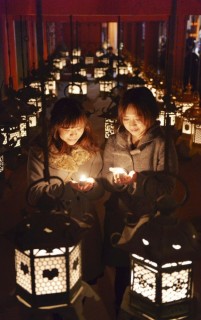Loading
Search
▼ Festival / Candlelight of 3,000 lanterns illuminates world of antiquity
- Category:Festival
At Kasuga Taisha shrine in Nara, each of the more than 3,000 lanterns in the precincts are lit up three days a year, namely on Feb. 3 and Aug. 14-15, between 7 p.m. and 9:30 p.m. for the summer event and 6 p.m. and 8:30 p.m. for the winter event.
This tradition has continued for 800 years and most of the lanterns have been donated by ordinary citizens with the exception of a handful which had been dedicated by samurai warriors. Such scenery lit only by candlelight takes you back into bygone days of no electricity and is full of mysticism. The reflections of the light on the river surface and the vermilion buildings of the shrine strike a beautiful harmony.
There are stone lanterns in the gardens and hanging lanterns in the corridors. The garden lanterns are decorated with strips of Japanese paper inscribed with people’s wishes, and are lit by the participants. The hanging lanterns in the corridors come in a variety of designs. It appears that the number of lanterns corresponds to the number of wishes. Formerly, these numerous lanterns were lit up every night, which is quite amazing.
Feb. 3 marks the transition from winter to spring known as Setsubun, when beans, good luck charms and a votive picture of a horse, which are items for securing a long life, are sold from early morning.
It is also worthwhile to take a stroll in the shrine precincts in the daytime. In summer, you can enjoy watching the performance of dancers dressed in ancient kimono.
(Information from the Japan National Tourism Organization website http://www.jnto.go.jp/eng/)
Setsubun Mantoro
Place: Kasuga Taisha shrine in Kasuganocho, Nara
Date: Feb. 3
- January 25, 2016
- Comment (0)
- Trackback(0)


